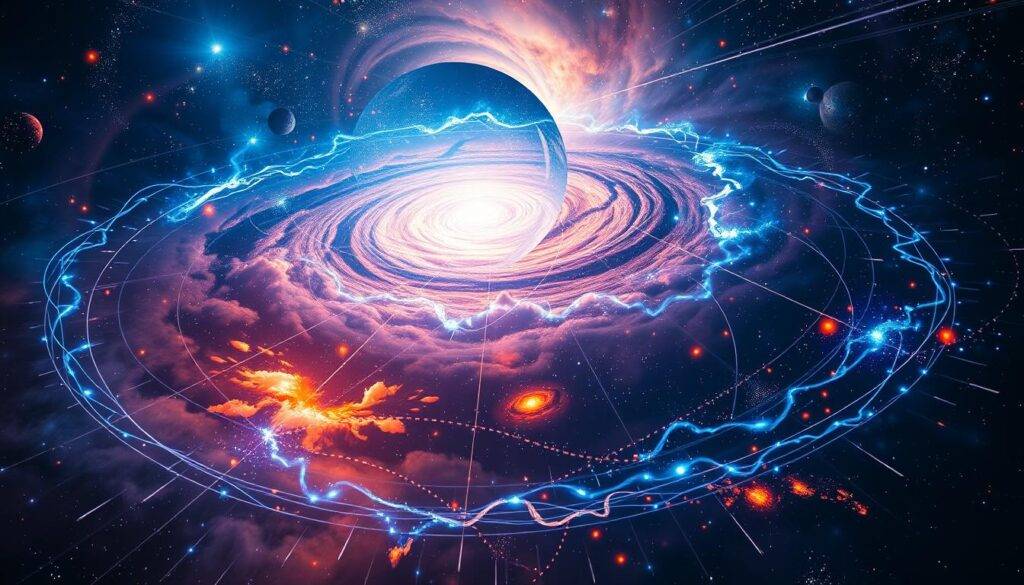“The universe is full of magical things patiently waiting for our wits to grow sharper.” – Eden Phillpotts
The cosmos is a grand show of celestial bodies dancing together. But there’s a hidden force that fills the universe – magnetism. Astronomers have found magnetic fields in distant parts of the universe. They stretch from galaxy clusters to the vast spaces between them, creating a cosmic web of invisible forces.
The discovery of the largest magnetic field ever seen has sparked a lot of interest. It stretches 10 million light-years across a cosmic web filament. The magnetic universe theory says these fields are not just byproducts. They are key players in how the universe evolved.
Key Takeaways
- Astronomers have detected magnetic fields permeating entire galaxy clusters and the vast spaces between them.
- The largest magnetic field ever observed spans 10 million light-years across a cosmic web filament.
- The magnetic universe theory suggests that these omnipresent fields play a crucial role in the evolution and structure of the cosmos.
- Unraveling the mysteries of cosmic magnetism could lead to a deeper understanding of the early universe and the fundamental forces that govern it.
- Advances in detection methods, such as the use of LOFAR radio telescopes, are shedding new light on the ubiquitous nature of magnetic fields throughout the universe.
Understanding the Fundamentals of Cosmic Magnetism
The universe is filled with plasma and electric currents. These elements create the amazing galactic dynamics we see. At the center of this dance is magnetic fields, a key force that shapes our universe.
Basic Principles of Magnetic Fields
Magnetic fields come from electric charge flow. The Earth’s magnetic field comes from its inner dynamo. These fields grow and get stronger by aligning with weaker ones, forming complex patterns across galaxies.
Magnetism, along with gravity, is a force that shapes large cosmic structures. It does this over vast distances.
The Role of Electric Currents in Space
Electric currents in space are key to creating and keeping cosmic magnetic fields. These currents flow through the plasma that fills the universe. They help guide the movement of stars and galaxies.
Magnetic Force vs Gravity in Space
Gravity is known for shaping the universe’s large-scale structure. But magnetic fields also play a big role. The mix of magnetic force and gravity is complex and fascinating. It shows how each force affects the growth of galaxies and galaxy clusters.
| Magnetic Field Characteristics | Observed Phenomena |
|---|---|
| Parallel to spiral arms in galaxies | Concentrated at inner edge or between arms |
| Regular fields with constant direction | Revealed by Faraday rotation angles |
| Outflow speed in galaxy winds | Typically around 300 km/s |
| Exponential scale heights in radio | Suggest existence of galactic winds |
The basics of cosmic magnetism are key to understanding the plasma universe and galactic dynamics. As we explore these mysteries, we see the complex forces that shape our universe.
The Magnetic Universe Theory: Evolution and Development
The Magnetic Universe Theory has grown a lot as scientists find magnetism everywhere in space. It shows that magnetic fields are key in forming our universe’s structure. These fields might have started when the universe was very young.
Our understanding of the Magnetic Universe Theory has improved a lot. New tools like the Wilkinson Microwave Anisotropy Probe (WMAP) have given us new views of the early universe. They show that the first stars were born just 400 million years after the Big Bang. This makes scientists look into how magnetic fields and intergalactic magnetic fields help shape the universe.
Looking at distant galaxies, like the amazing 9io9, has shown us magnetic fields in the early universe. The light from 9io9, a galaxy from 2.5 billion years ago, tells us about magnetic fields in galaxies. It shows how these fields have changed over time.
“The magnetic field around the galaxy 9io9 gives us valuable insights into how galaxies and their magnetic fields have evolved throughout cosmic history.”
As we learn more about plasma cosmology and magnetic fields, the Magnetic Universe Theory is more important. New tools and observations will help us discover more about our universe’s magnetic nature.
Detecting Magnetic Fields Across Space
Astrophysicists are on a quest to understand magnetic fields in space. They study everything from Earth’s magnetic field to huge fields in galaxy clusters. Knowing how magnetism shapes the universe is key to understanding its history.
Modern Detection Methods
Scientists use advanced methods to find magnetic fields in space. Faraday rotation measurements are a top tool. They create 3D maps by watching how light changes as it goes through these fields.
LOFAR and Radio Astronomy
The Low-Frequency Array (LOFAR) is a network of 20,000 radio antennas in Europe. It helps find magnetic fields in cosmic filaments. By studying signals at low radio frequencies, researchers spot these fields.
In one filament, a magnetic field stretches 10 million light-years. This discovery has sparked a lot of interest in astrophysics and plasma astrophysics. Scientists are eager to learn more about these huge fields.
Synchrotron Radiation Signals
Synchrotron radiation shows where magnetic fields are. It comes from charged particles moving in these fields. By looking at the radiation’s intensity and type, scientists can figure out the field’s strength and shape.
LOFAR detected this radiation in a magnetized filament. They’re analyzing 50 hours of data to learn more. This research aims to uncover the mysteries of astrophysics and plasma astrophysics.

“Magnetism is considered a primordial force that might exist everywhere in the universe.”
Origins of Primordial Magnetic Fields
The universe’s primordial magnetic fields have always fascinated scientists. They wonder how these cosmic magnetic fields first appeared. Many theories exist on how these fields were created in the early universe.
One idea links the formation of dark matter mini-halos to magnetic fields. A study from Italy’s International School for Advanced Studies (SISSA) found a connection. They think the strength of magnetic fields right after the Big Bang might have influenced the number of these mini-halos.
This study was published in Physical Review Letters. It uses a new way to study magnetic fields and dark matter. Lead author Pranjal Ralegankar believes this method could reveal important details about the universe’s early days.
Even though magnetic fields from some processes are weak, others are much stronger. The challenge is understanding how these fields grew so large over time.
“The proposed method to detect primordial magnetic fields is indirect and based on analyzing the influence of magnetic fields on dark matter. The theoretical findings suggest that the abundance of mini-halos of dark matter in the universe is determined by the strength of primordial magnetic fields in the early universe, possibly within 1 second after the Big Bang.”
Scientists are still learning about the links between cosmology, electromagnetism, and dark matter. Their research on primordial magnetic fields could change how we see the universe’s growth.
Magnetic Fields in Galaxy Clusters and Filaments
Explore the plasma universe, where magnetic fields are key. They shape the cosmic web in galaxy clusters and filaments. These magnetic structures connect celestial events, showing how plasma and magnetism interact.
Intergalactic Magnetic Structures
Research shows magnetic fields in cosmic filaments are strong and widespread. These structures help us understand the universe’s large-scale structure. Studying plasma and magnetic fields helps us grasp the cosmic web’s complexity.
The Role of Plasma in Cosmic Magnetism
Plasma, the fourth state of matter, is crucial in understanding the magnetic universe. Its dynamic interactions with magnetic fields shape the universe’s fabric. The study of plasma and magnetic fields is key to unlocking cosmic magnetism’s secrets.
| Magnetic Field Strength | Observation |
|---|---|
| ∼μG | Magnetic fields and ultra-relativistic electrons (γ≳104) detected in around 50 galaxy clusters |
| ≳ nG | Filaments connecting galaxy clusters are suggested to be magnetized |
| 0.03–2 μG | Presence of magnetic fields recognized in all galaxy clusters, with upper limits on their strength |
“The presence of magnetized plasma in these structures provides important insights into the formation and evolution of the cosmic web.”
Studying plasma and magnetic fields helps us understand the universe. It reveals the processes that shape the cosmic web. This knowledge deepens our understanding of the magnetic universe and its implications.
The Connection Between Magnetism and Cosmic Structure
Magnetic fields are key in creating and changing cosmic structures. This includes stars, galaxies, and more. They affect plasma, which makes up almost all visible matter in the universe. Understanding how magnetic fields and plasma work together helps us grasp star birth, galaxy growth, and the intergalactic medium’s behavior.
A recent study in Nature Astronomy on August 28th found magnetic fields in a galaxy 4.6 billion light-years away. This is the farthest such measurement ever. Researchers used gravitational lensing to see the magnetic field in the galaxy up close.
This breakthrough, thanks to the National Radio Astronomy Observatory’s Very Large Array, shows magnetic fields’ importance in galaxy formation and growth. As we delve deeper into galactic dynamics and plasma cosmology, we learn more about magnetism’s role in our universe.
| Observation | Finding |
|---|---|
| Magnetic field measurement of a distant galaxy | Successful measurement of magnetic field structure in a galaxy 4.6 billion light-years away, the farthest such observation to date. |
| Gravitational lensing | Gravitational lensing was used to magnify the light from a quasar, allowing researchers to study the magnetic fields in the foreground galaxy. |
| Observational instruments | The National Radio Astronomy Observatory’s Very Large Array, consisting of 27 radio telescopes in New Mexico, was used to observe the distant galaxy. |
| Significance of the study | This was the first successful measurement of the magnetic field structure of a galaxy so distant in space and time, providing new insights into the connection between magnetism and cosmic structure. |
As scientists keep exploring galactic dynamics and plasma cosmology, we’ll learn more about our universe. The findings from this study and others will help us understand the universe’s forces and structure better.

Plasma Physics and Universal Magnetism
Plasma physics is key to understanding cosmic magnetic fields. Plasma, an ionized gas, shapes the universe’s magnetic structures. The Alfvén effect, named after Hannes Alfvén, has changed how we see cosmic magnetism.
Plasma Dynamics in Space
Plasma is everywhere in the universe, from the sun’s corona to space between galaxies. Its behavior is influenced by electric and magnetic fields. Plasma helped create our solar system and shapes events like solar flares.
The Alfvén Effect in Cosmic Plasmas
Hannes Alfvén’s discovery of the Alfvén effect changed plasma astrophysics. It shows how waves move in magnetized plasmas. This effect is crucial for understanding cosmic structures and how energy moves across the universe.
“The same basic laws of plasma physics apply from laboratory settings to interstellar and intergalactic plasmas.”
The Plasma Universe Theory, led by Alfvén, questions the Big Bang theory. It suggests the universe evolves with electricity, magnetism, and plasma. This theory offers new insights into cosmic origins and evolution.
Our understanding of plasma physics and cosmic magnetism is growing. This knowledge challenges modern cosmology. By studying plasma astrophysics and electric currents, we can reveal the magnetic universe’s secrets.
Impact on Modern Cosmological Theories
The Magnetic Universe Theory shakes up some key ideas of the Big Bang model. It offers new ways to explain cosmic events. Famous astrophysicists have found that the universe might not be expanding, which goes against the Big Bang theory. This theory also sheds light on how light elements formed and the early universe’s structure, changing how we see cosmology and astrophysics.
This theory questions the universe’s shape. The Big Bang model says the universe is flat and has no special points. But, the cosmic microwave background radiation shows a flat universe with a big hotspot, making us wonder about this idea.
The Magnetic Universe Theory also doubts the existence of dark energy. In the Big Bang model, dark energy makes up about 70% of the universe’s energy. This theory offers a new view on dark energy, possibly solving the problem of why the universe’s mass density was just right after the Big Bang.
It also tackles the isotropy problem in the Big Bang model. This problem is about why the cosmic microwave background radiation is so uniform everywhere. By including magnetic fields, this theory gives a better explanation for this phenomenon.
As scientists delve deeper into the Magnetic Universe Theory, it’s clear it could change how we see the universe. It challenges old ideas in cosmology and astrophysics. This groundbreaking theory is set to take the field of astrophysics in exciting new paths.
“The Magnetic Universe Theory is a game-changer in the field of cosmology, offering a fresh perspective that challenges the fundamental assumptions of the Big Bang model. Its potential to redefine our understanding of the universe is truly remarkable.”
The Hubble Tension and Magnetic Fields
In the field of cosmology, scientists have found a puzzling issue called the Hubble tension. This problem comes from different ways to measure how fast the universe is expanding. The rate from the cosmic microwave background is about 10% less than what we see from stars and galaxies.
Primordial magnetism might solve this mystery. Adding weak magnetic fields from the early universe to the Standard Cosmological Model helps. This way, the universe’s expansion rate matches what we see from far-off objects.
This idea doesn’t need new particles or changing Einstein’s theory. It uses magnetism, a force that shapes our universe.
| Observed Hubble Constant | Inferred Hubble Constant |
|---|---|
| Higher | Lower |
We need to test this idea. Finding signs of early magnetic fields in the universe could prove it. Studies on these fields at different cosmic stages could give us the proof we need.
“The proposal by Pogosian and Jedamzik aims to reconcile the predicted Hubble constant with the one directly observed by altering the time of transition from opaque to transparent universe.”
Exploring electromagnetism in the universe could lead to solving the Hubble tension. This shows how connected the universe’s forces are and the power of science.
Future Research and Implications
The study of cosmic magnetism is just starting to open up new areas of research. Scientists are excited to improve how we detect magnetic fields in space. They will use new technologies to get a deeper understanding of the universe.
Emerging Technologies in Field Detection
New radio telescopes, like the Square Kilometre Array (SKA), will be very sensitive. They will help us see the magnetic fields in galaxies and galaxy clusters in great detail. Space-based observatories, like the Laser Interferometer Space Antenna (LISA), will also play a key role. They will study gravitational waves, which could show us the magnetic fields from the universe’s early days.
Potential Breakthroughs
With these advanced tools, scientists are ready to make big discoveries. They could change how we see the universe’s structure and how it evolved. Finding out how magnetism affects cosmic structures could be a major breakthrough. It could also help us understand the universe’s earliest moments better.
FAQ
What are the key insights from the Magnetic Universe Theory?
The Magnetic Universe Theory says magnetic fields are key in creating cosmic structures. They might have been there from the start. Astronomers find magnetic fields everywhere in the universe, even between galaxies.
How do magnetic fields arise in the universe?
Magnetic fields come from electric charge moving. Earth’s magnetic field comes from its core. These fields get stronger by aligning with others. Only magnetism and gravity can shape the universe on a large scale.
What are the modern methods used to detect cosmic magnetic fields?
Scientists use signals from synchrotron radiation and Faraday rotation to find magnetic fields. LOFAR, a network of radio antennas, helps see magnetic fields in cosmic filaments.
What are the proposed theories for the origin of primordial magnetic fields?
Scientists think primordial magnetic fields could have started during the electroweak phase transition or proton formation. They might have even begun during cosmic inflation. The pattern of magnetic fields could tell us how they started.
How do magnetic fields shape the large-scale structure of the universe?
Magnetic fields are vital in creating and changing cosmic structures, from stars to galaxies. They affect plasma, which makes up most of the universe’s visible matter. Understanding how magnetic fields and plasma work together is key to many cosmic phenomena.
What is the significance of plasma physics in understanding cosmic magnetism?
Plasma physics is crucial for understanding cosmic magnetism. The Alfvén effect shows how waves move in magnetized plasmas, shaping the universe. Plasma was important in our solar system’s formation and still affects astrophysical events.
How does the Magnetic Universe Theory challenge existing cosmological models?
The Magnetic Universe Theory questions some Big Bang model parts and offers new explanations for cosmic events. It suggests the universe might not be expanding, unlike the Big Bang theory. It also sheds light on how light elements formed and the early universe’s structure.
How can primordial magnetism help resolve the Hubble tension?
Primordial magnetism might solve the Hubble tension, a problem with the universe’s expansion rate. Weak early universe magnetic fields could explain the faster expansion rate we see today. This could be a big breakthrough in cosmology.
What are the future research directions in cosmic magnetism?
Future research will aim to better detect and understand cosmic magnetic fields. New technologies will help measure these fields more accurately. Breakthroughs could change how we see the universe’s structure, evolution, and forces.




























































